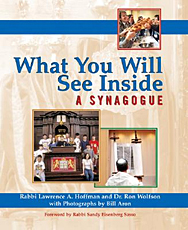Showing Our Thanks
"Five days after Yom Kippur, we show our thanks in a harvest holiday called Sukkot.
"Long ago, our ancestors who were farmers built small huts in their fields during the harvest season. They stayed there day and night while gathering their crops. Today, we too build a temporary outdoor hut called a sukkah. It is decorated with tree branches, garden vegetables hung up on a string, and, sometimes, the New Year greeting cards that we received for Rosh Hashanah.
"After prayer service, we go to the sukkah for kiddush. Even though the people build a sukkah in their synagogue, many families build one at home, outdoors — in their yard, perhaps, or on the roof of their apartment building — so they can see the sky just the way the farmers long ago must have. Some people eat all their meals and even sleep in their sukkah.
"Sukkot is a holiday of hospitality. 'Pretend guests,' like the great men and women of the Bible, are invited to visit. Real guests come to eat there also. If you are invited to a sukkah, you can bring something to hang up as part of the decoration.
"During Sukkot prayer services, we use a lulav and an etrog. The lulav is a bundle of branches from trees that are mentioned in the Bible. They grow in Israel, but, depending on where you live, they might also grow in your backyard. The etrog is a fruit that looks like a lemon. People hold these objects together and wave them in all four directions, thanking God for making things grow all over the world."
